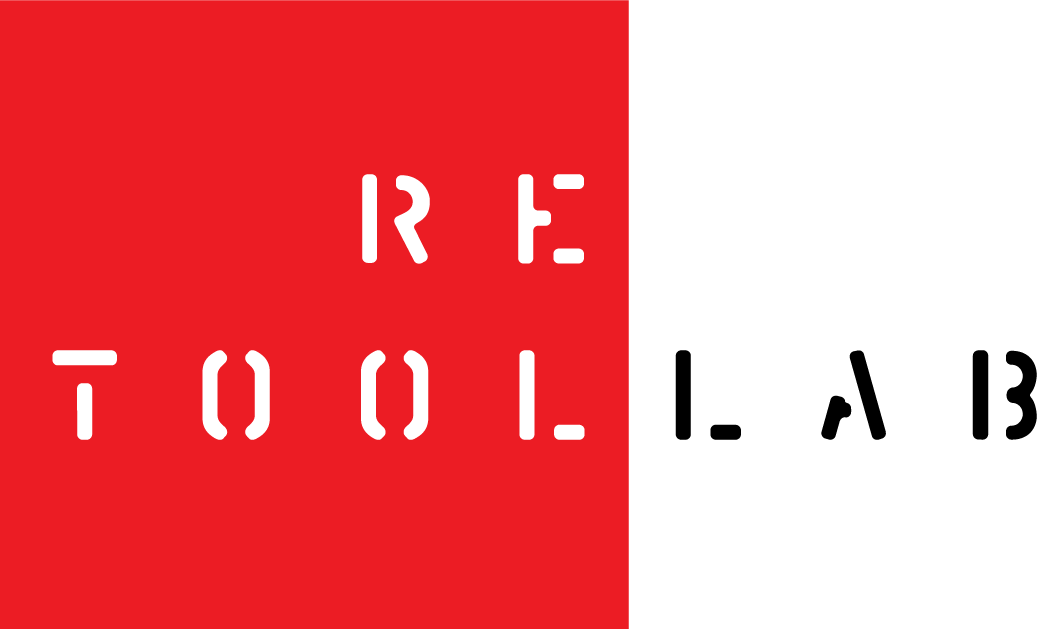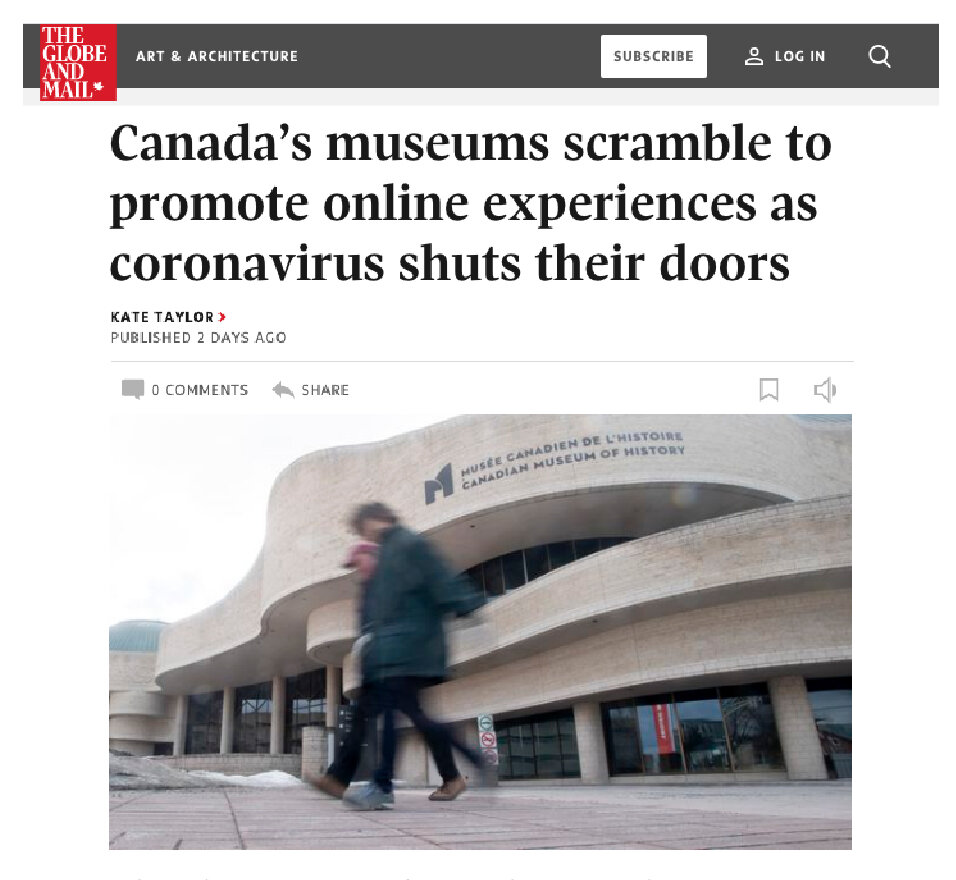A time of reckoning for museums
Kate Taylor writes in the Globe and Mail (“Canada’s museums scramble to promote online experiences as coronavirus shuts their doors,” 19 March 2020) that the Canadian Museums Association (CMA) is petitioning the federal government for a relief fund that provides new money for digital activities. Instead of being distracted by March Break scavenger hunts and overnight camps, museums should have focused sooner on how to keep in touch with absent visitors; most haven’t.
The need for introspection isn’t reserved for Canadian museums: Holland Cotter writes in the New York Times that this is an opportune moment for museums “to rethink the Temple of Beauty branding they’ve coasted on from the start” and to reconsider what they are. Their mission remains valid and important, Cotter says, and he acknowledges “objects can be persuasive teachers. But in a distracted, memory-stunted age, museums require new interpreters” capable of reconsidering “their own role as history-tellers.” In short, museums need to be something more than a cabinet of wonders.
Museums occupy a special place in society, one that is crucial to how we understand ourselves. Their role is not merely to educate and entertain but is, more importantly, to challenge our thinking and help us reflect as a society; make us better-informed and more responsible citizens, and to be places of ideas that build their brands around shaping society’s conversations.
But just when museums should be seen as influencers – what society needs them to be – they summarily get diminished as non-essential distractions. Their broader societal value is under-appreciated, due in part to the fact that most museums rely heavily on providing in situ visitor experiences, thus limiting their ability to meaningfully engage a broader, more diverse, more global audience and to grow their influence. Further limiting their role as leaders, museums tend to over-emphasize the use of special exhibitions, an approach that is less conducive to promoting the uniqueness of their own collections, their leadership, and their perceived value as cultural institutions.
Now more than ever, museums should feel compelled to engage and retain the attention of people (and politicians) distracted by other more “alluring” choices and priorities. To build a leadership brand, museums require a strategy focused on the institution’s core purpose, paired with a multi-pronged outreach program that leverages suitable publishing approaches. Their thinking and ability to influence and engage populations must project far beyond their walls, and definitely beyond the next slate of special exhibitions. Most importantly, to help ensure their future relevance, they would do well to consider that their audience is not limited to just the “customers” who pass through their turnstiles.
What does it mean, and where can we start?
Building the right brand the right way requires lessening museums’ heavy reliance on their traditional marketing and communications approach, so they can prove there is meaning and depth behind their claim of value. Museums can become laboratories for innovation. But they need to develop the capacity to provide curated experiences that, as Rosabeth Moss Kanter, professor at Harvard Business School puts it, “Think Outside The Building.” This means success metrics cannot be limited to the number of actual in situ visitors.
When “only so many” people can physically visit, museums have to figure out how to reach an audience that may never have an opportunity to travel to the museum itself. That now means telling stories to engage new and more global audiences. Giving people something to talk about, something worth listening to can be a game changer. The brand rooted in leading ideas – sustained by one’s intellectual leadership – will be the catalyst for success: the most effective way to be understood, to be authentic and credible.
People have an appetite for deeper accounts of history, science, and the environment that tell us how things got to be the way they are, and even where society might go from here. Are our assumptions about the content Millennials want – pithy YouTube videos – correct? We hope not. The media is endlessly fascinated with the stereotype of a creative, hyper-connected, lazy, and narcissistic generation with a shrinking attention span. It’s time to let go of these tired myths. It just so happens, according to Forbes, this “lazy” generation reads more than previous generations at the same age. They are also much more open to different types of experiences. They aren’t giving up on traditional printed books however, but are also consuming vast quantities of electronic text, everything from blogs to online magazine and newspaper articles. As this generation matures, we will not be able to overstate the importance of original and compelling stories.
If they fail to act on this, museums will remain institutions that are permanently at risk.
Indefinite closings mean museums face severe, monetary shortfalls. Our recent post entitled “Purpose in a Time of Pandemic” is one of a number of articles about the state of museum branding today. It begins with the provocative question: “What would you do if people stopped coming?” It was written and posted before the coronavirus pandemic reached North American shores, as we foresaw the almost unavoidable consequences we are presently in the midst of experiencing. We believed, as has been born out by this past week’s events, that our question was particularly pertinent, but also one that is useful for museums to ponder at any time, including in "good times," as it forces one to seriously consider whether their present and “tried-and-true” business model is still sound. We believe museums need to reflect on their respective core purposes and define new strategies to live by, to release and leverage the institutional value trapped within their walls – their research, their science, their academic and educational content – and begin to look at communications not as an outbound activity but as a much needed public engagement platform helping ensure their continuous place and relevancy at the very heart of culture and society.
Museums that are content to simply digitize their collection in order to display it on their website will not be successful in building a brand that demonstrates the societal value of their institution; while a necessary step, it will not attract and retain the audiences they expect. Furthermore, they will not be doing anything different from all other museums who will also be scrambling to figure out how to monetize their activities and derive incremental revenue from engaging those more distant “digital” audiences they so desperately want to reach. A new business model will be required.
Organizations have long known they can’t meet their goals without a brand, it is time they learned they won’t get an effective brand unless they communicate substantively. And communicating substantively is not about technology. It is about engaging with audiences and sharing stories that shape the conversation. In The Attention Economy, Thomas Davenport and John Beck wrote that “people with something to say, or a unique and creative way of saying it, are your organization’s best hope of getting attention.” This is a truism regardless of generation or the impact of technology.
Trust builds around organizations that explain why they are leaders and why they deserve the public’s support.
Providing the public with something meaningful and relevant to think (and talk) about, allows the organization to engage audiences beyond the perimeter of its four walls and connect millions of people to its leading ideas.
Putting your organization at the center of a vital public conversation allows one to become the focal point for discussion and to shape the conversation.
This has been the crux of Argyle Brand Counsel+Design’s consultation with Winnipeg-based Canadian Museum for Human Rights (CMHR), an important voice on the global stage, and the first museum in the world dedicated to the history and understanding of human rights. This remarkable and unique institution has to contend with, and attempt to overcome, the challenges of being located in a mid-sized market hundreds of miles away from large North American urban population centres – a fact that greatly limits its ability to increase, let alone maintain, high attendance numbers. The answers for the CMHR have to draw on a different set of strategies. This ideas museum, devoted to dialogue, requires a storytelling capability that extends its messages far beyond its four walls. Innovation in developing new forms of engagement will help ensure its future viability.
The Toronto Zoo (and the Toronto Zoo Wildlife Conservancy which supports the Zoo) wrestles with a similar dynamic. Wanting to be a global leader in the rehabilitation of wildlife species, it nevertheless struggles to justify its existence to a city council on which it depends for a good portion of its funding; to politicians who, like the majority of the public, see the Zoo largely as an entertainment venue or wildlife-based theme park, and not as an important and world-leading research organization adding vital missing knowledge to our knowledge of conservation science. Yet the Toronto Zoo does play an indispensable role connecting and educating millions to wildlife conservation, with a mission and function that goes well-beyond the display of wild animals.
These, and nearly all other cultural institution of any scope, must grow their influence by asserting their leadership on various levels and tell their story to a far broader audience in order to reach their goals and ensure their future viability. Their journey should begin with overhauling their brand communications and broadening their engagement approach. Technology alone won’t do it; the solution is deep content, which they must leverage to build a brand that resonates with a more diverse audience, and reinforces the societal value of museums in ways that are relevant to people’s expectations.
For well over a decade we have been advocating for change. Our self-published works ContraBrand: Build a Better Nonprofit (2008) and The Alchemy of Content: How Publishing Creates Sustainable Museums (2011) lay the groundwork for various sectors, (cultural institutions particularly), to build brands that leverage the academic research and scholarly knowledge that lay trapped deep inside their institutional vaults, and deploy it to define new and innovative engagement tools and strategies to a broader, more diverse and more global audience. Our more recently-instituted Leadership BrandingTM practice extends this argument along the same lines, but goes further in attempting answers to questions regarding the monetization of such deep content strategies, by looking at various models museums could consider, like the need to develop many of the skills most closely associated with media companies. Such approaches are potentially transformative undertakings where purpose-driven organizations could more easily marshal the deep intellectual capital hiding at their core, and make it the cornerstone of their brand.
Your leadership story can change the world. Or save your organization. Or both. But no one can hear your story if you don’t tell it, and tell it well. There is a cost to being passive about telling people what you know: you marginalize yourself by not speaking out. Think like a media organization and tell stories with a purpose. Shaping the conversation will make you an indispensable organization. That will also bring more people through your doors once they reopen.
Retool Lab is a collaborative focused on helping cultural, entertainment and public institutions regroup, reshape, and retool their strategy to recover from the economic impact of the current crisis, and to use these insights as a springboard to thrive far into the future. You can contact us at info@retoollab.com or at www.retoollab.com

